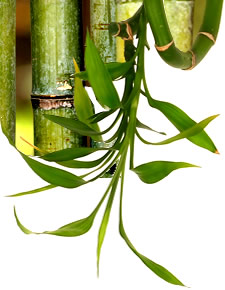

Bamboos shoot to stardom |
LET'S face it, bamboo to most gardeners is simply the stick that holds up the runner beans. But in recent years, the bamboo plants themselves have found their way into garden centres and we now have a wide range of species to choose from. Certainly, some can grow to be enormous; a stroll through the bamboo garden at Kew reveals the huge scale of certain varieties. But bamboos are no different from any other garden plants in that it's important to choose the right variety to suit your purpose: some bamboos make great ground cover while others make superb plant specimens. Some make dense, easy-to-manage hedges. While the difference in size is vast, bamboos do have a common feature: from the tiniest to the tallest plant, they each have exotic, oriental appeal. The plants are also known for the intriguing sound they bring to the garden. Susurration is the term for the whispering of foliage rustling in the breeze. Bamboo foliage can vary in colour: usually it is green but variegated species and other colours are available. Similarly, stems can be green, gold, yellow or black, or a combination of these colours. Most varieties enjoy similar garden conditions, although there are a few exceptions to the rule. Most prefer an open, sunny spot, though a few like a dark, shady patch. All enjoy rich feeding and most appreciate plenty of moisture, but no plants can handle waterlogging. Bamboos also have in common an extraordinary way of flowering. Unlike most other plants, bamboos flower only very rarely. On the odd occasion that they do, it is often the case that all the plants of a given species anywhere in the world - be they in the wild, in gardens or in conservatories - flower at the same time. Unfortunately, flowering occurs so rarely that we gardeners are unlikely to ever witness it. This irregularity poses a problem for botanists, whose job it is to classify and name plants based on their flowers: with flowering so uncommon, some species are known by several different names, causing plenty of confusion. SO, let's pick five bamboos that make excellent garden plants and are not difficult to find. Phyllostachys nigra: a splendid specimen, its black stems stand out against a pale background. Much in evidence at this year's Hampton Court Palace Flower Show. Pleioblastus auricomis: this species has rich gold- and green- striped leaves. For the best effect, cut the whole plant to the ground every spring. Fargesia murieliae: tough and elegant, its branches arch attractively under the weight of the foliage. It makes a great screen or windbreak. Pleioblastus variegatus: a neat plant with white- and green- striped leaves, this plant also benefits from regular cutting back. Sasa veitchii: makes an excellent ground cover, and is not invasive. The edges of the leaves dry to a surprisingly attractive biscuit brown in winter. Bamboos are turning up in more and more garden centres, but if you have trouble finding them, send five first-class stamps to bamboo specialists PW Plants, Heath Road, Kenninghall, Norfolk, NR16 2DS, and they will post you a catalogue. Save the stag beetle WHEN I was a child, stag beetles were a familiar sight on London's suburban pavements - easy prey for nasty boys who would either capture or stamp on them. But this is not the reason they've become so rare and are now a globally threatened species. Young stag beetle grubs like to munch on old oak logs. They also enjoy ash, lime, elm, sycamore and other deciduous trees, but they're not pests because they never eat live wood. As more and more people tidy up their gardens, the beetles' habitat is disappearing. Do your bit by leaving a few logs in the corner of the garden if you cut down a tree. Next time you buy firewood, keep some logs aside for the beetles. Find out more on the London Wildlife Trust's website (www.wildlondon.org.uk) Gardening week Snip the dead flowers off roses, geraniums (right) and other container plants to encourage more flowers. Keep tomatoes moist to prevent the skins splitting, and pinch out the plant's side shoots. Feed tubs, baskets and other containers each week with a specialist container food or liquid tomato feed. Trim bay trees to keep them neat and shapely. Use any prunings longer than 8cm as cuttings. Beware of using weedkillers on dry lawns as this could damage the grass: wait for rain or water the lawn first. Keep your vegetables cropping by pulling radishes and baby carrots, picking peas and cutting lettuces. If pests are starting to become a problem in the greenhouse and conservatory, biological control is the safest way of dealing with them. Phone Defenders (01233 813121) or the The Green Gardener (01603 715096) for details. |
© Copyright yayixm.com All rights reserved. Unauthorized duplication in part or whole strictly prohibited by international copyright law. |
|
|